Haniwa were produced as funerary sculptures to decorate specific burial mounds in the Kofun period, at the time the first Japanese state was being formed, from the 3rd to 6th centuries AD. More than thirty pieces of Haniwa were excavated from the ditches of Burial No. 8 of the Yoshida-Nihonmatsu burial cluster. They include normal cylindrical haniwa and cylindrical haniwa with open tops, as well as representational haniwa of anthropomorphic, horse-shaped, and house-shaped type. This collection is representative of the haniwa assemblage of the Kofun period in Kyoto.
| HOME | Exhibition Top | CESCHI | CESCHI(Faculty) | Kyoto University |
| ⇒ Prev (Jomon-Yayoi) | ⇒ Next (Modern) |
| Haniwa | |
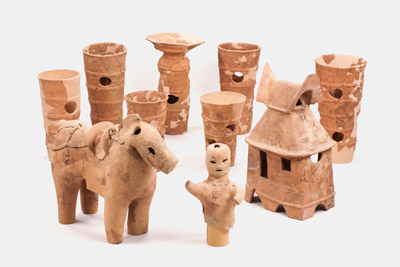
|
Age |
The end of 5th c. (Middle Kofun Period) |
|
| Location | |
Yoshida-South Campus |
|
| Caption | |
|
|
|
| ⇒ Return to Top | |
| Pottery as grave goods | |
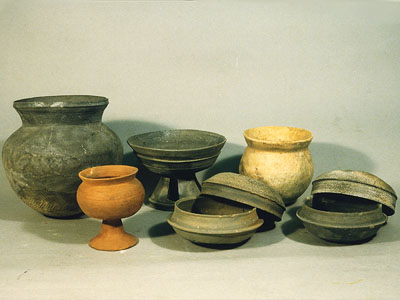
|
Age |
5th-6th c. (Middle Kofun Period) |
|
| Location | |
Yoshida-South Campus |
|
| Caption | |
|
Dedicated pottery found from the burial mounds (kofun), tentatively called the "Yoshida-Nihonmatsu" kofun cluster, which are composed of six ditched square mounds. A yellowish brown coloured jar and a reddish brown coloured pedestal bowl are the Haji type; fired in the traditional way. Others are the Sue type, whose firing technique, namely kiln firing, was introduced from the continent around this period. |
|
| ⇒ Return to Top | |
| Pottery for aristocracies | |
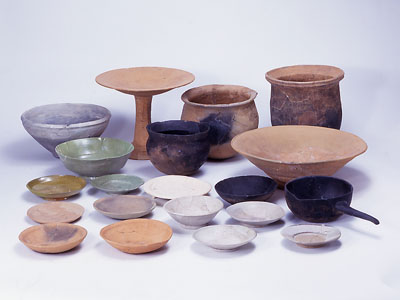
|
Age |
Late 9th c. (Early Heian Period) |
|
| Location | |
North Campus |
|
| Caption | |
|
Vessels of various forms abandoned in the junction of two ditches. All of them were found in a heap of broken pots from about 100 individuals. They includes a number of bowls and dishes of very superior quality, such as green-glazed or ash-glazed stoneware made in the Sanage kilns; one of the highest standardised manufacturing area for stoneware at that time. Such fine wares, as well as an extraordinary tripod-dish of white colour, suggest that this site had been occupied by aristocracies. |
|
| ⇒ Return to Top | |
| Horse-shaped clay figurine | |
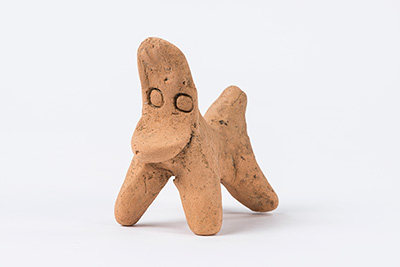
|
Age |
Late 9th c. (Early Heian Period) |
|
| Location | |
Yoshida-South Campus |
|
| Caption | |
|
This lovely piece, measuring 6 cm in height and 5 cm in length, was found at the bottom layer of the well of Heian Period. No damage to the whole body other than the tip of the tail allows us to typologically date it to the late 9th century, which is consistent with the date of accompanying artefacts in this well. Being found almost intact at the bottom layer, this figurine might well have been intentionally deposited as part of a ritual relating to water supply. |
|
| ⇒ Return to Top | |
| Pewter burner | |
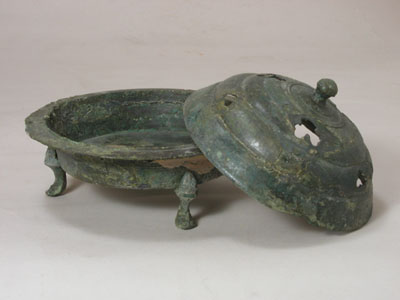
|
Age |
11th-12th c. (the end of Heian Period) |
|
| Location | |
University Hospital Campus |
|
| Caption | |
|
An incense burner found together with another pewter bowl; both possibly used for an esoteric Buddhist service. This burner, its cap with the diameter of 11cm having heart-shaped openwork, was painted with gold dust, faintly remaining on the surface. Very similar burners have been found at Hanase in Kyoto and at Wakayama, which are dated to the end of the 11th century. The service might have been related indirectly to one of the retired Emperors of this period living in the Shirakawa area. |
|
| ⇒ Return to Top | |
| Funerary urn | |
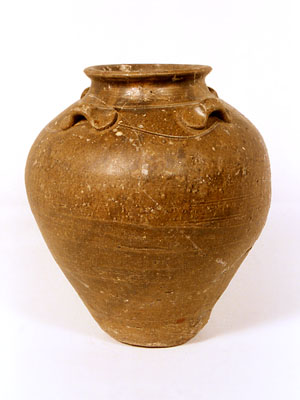
|
Age |
12th c. (Kamakura Period) |
|
| Location | |
Yoshida-South Campus |
|
| Caption | |
|
A brown glazed ware with four lugs, manufactured during the 12th century in China. The urn, 21 cm high, was found together with several stones of a skull size. This grave belongs to the cemetery of the 13th-14th century in which several graves with the trace of a wooden coffin have also been found, as well as various types of funerary urns such as stoneware and Sue ware. |
|
| ⇒ Return to Top | |
| Terminal roof-tiles of Medieval Period | |
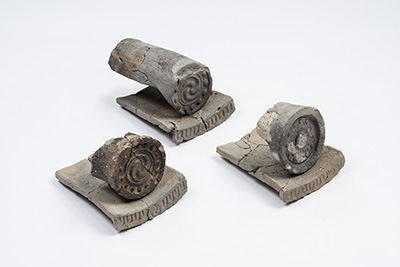
|
Age |
13th c. (Kamakura Period) |
|
| Location | |
West Campus |
|
| Caption | |
|
All these pieces are included in the collection excavated at the ruin of the estate of Kamakura period (c. 12-14c). Terminal tiles of this period became a little smaller than those of the ancient ones, and turned to have simple motifs of geometric pattern. Relatively small number of other normal roof-tiles in this collection indicates that the structure using these tiles was either a house roofed only on and around the ridge or a substantial roofed wall. This collection has another characteristic; more than a few pieces with the incised mark of various kind which is often regarded as the sign of craftsman are found. |
|
| ⇒ Return to Top | |
| Imported stoneware | |
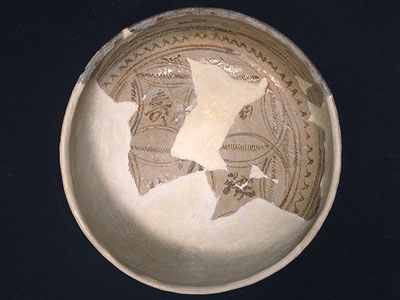
|
Age |
Mid 13th c. (Kamakura Period) |
|
| Location | |
Main Campus |
|
| Caption | |
|
A honey-colour glazed platter, 34cm in diameter, found in the pit filled with a considerable number of potsherds. This overlook photo shows that the set of four Chinese letters by iron-glaze drawings inside can read as the phrase which means "long life". The honey-colour glazed platter with the four letters is very rarely found in Japan. Compared with similar examples, this platter must have been produced in Quanzhou, the South China. |
|
| ⇒ Return to Top | |
| Lacquered bowl | |
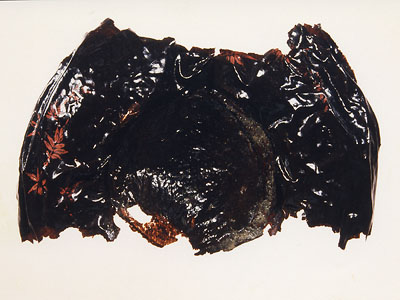
|
Age |
Kamakura period(A.D.13th Century) |
|
| Location | |
Faculty of Medicine Campus |
|
| Caption | |
|
A wooden bowl on which black lacquer was painted all over the surface, precedent to the elaborate lacquer drawing of bamboo leaves of red colour. This was recovered from the bottom layer of the fill of the well used by aristocracies of the late-13th century; the fill containing pottery of various kinds, some seeds of peach, and a steatite ink-stone. This photo, taken from the bottom side, also shows the distortion of the shape caused by depositing pressure of the fill. |
|
| ⇒ Return to Top | |
| Incense burner | |
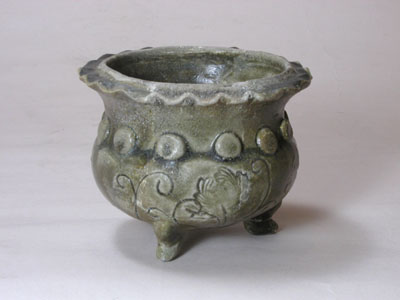
|
Age |
14th c. (Muromachi Period) |
|
| Location | |
Faculty of Medicine Campus |
|
| Caption | |
|
An all-over green-glazed tripod Ko-Seto stoneware, found in the upper layer within the fill of the cluster of mining pits of the mid-14th century. This burner has an elegantly outcurved rim with rippled edge, a carinated neck with a line of horizontally balanced applique, and a well-rounded body with engravings of lotus motif. |
|
| ⇒ Return to Top | |
| ⇒ Prev (Jomon-Yayoi) | ⇒ Next (Modern) |
| HOME | Exhibition Top | CESCHI | CESCHI(Faculty) | Kyoto University |